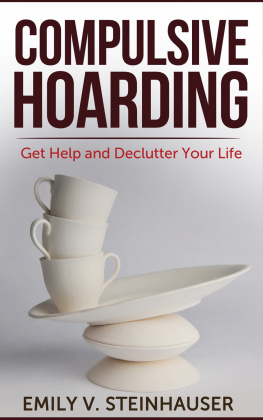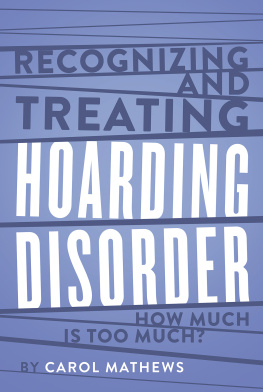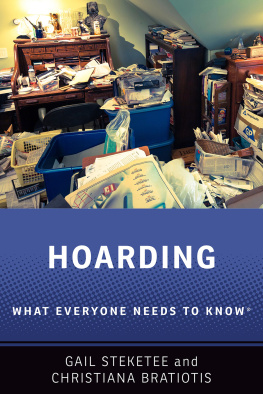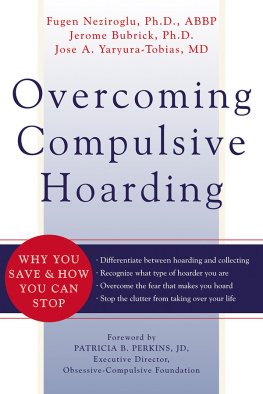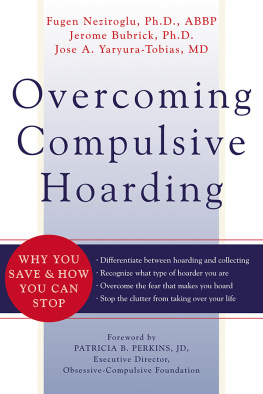Buried in Treasures
Buried in Treasures
Help for Compulsive Acquiring, Saving, and Hoarding
SECOND EDITION
David F. Tolin
Randy O. Frost
Gail Steketee


Oxford University Press is a department of the University of Oxford.
It furthers the Universitys objective of excellence in research, scholarship,
and education by publishing worldwide.
Oxford New York
Auckland Cape Town Dar es Salaam Hong Kong Karachi
Kuala Lumpur Madrid Melbourne Mexico City Nairobi
New Delhi Shanghai Taipei Toronto
With offices in
Argentina Austria Brazil Chile Czech Republic France Greece
Guatemala Hungary Italy Japan Poland Portugal Singapore
South Korea Switzerland Thailand Turkey Ukraine Vietnam
Oxford is a registered trademark of Oxford University Press
in the UK and certain other countries.
Published in the United States of America by
Oxford University Press
198 Madison Avenue, New York, NY 10016
Oxford University Press 2014
All rights reserved. No part of this publication may be reproduced, stored in a retrieval system, or transmitted, in any form or by any means, without the prior permission in writing of Oxford University Press, or as expressly permitted by law, by license, or under terms agreed with the appropriate reproduction rights organization. Inquiries concerning reproduction outside the scope of the above should be sent to the Rights Department, Oxford University Press, at the address above.
You must not circulate this work in any other form
and you must impose this same condition on any acquirer.
Library of Congress Cataloging-in-Publication Data
Tolin, David F.
Buried in treasures: help for compulsive acquiring, saving,
and hoarding /David F. Tolin,
Randy O. Frost, Gail Steketee. Second edition.
pages cm. (Treatments that work)
Includes index.
ISBN 9780199329250
1. Obsessive-compulsive disorder. 2. Compulsive hoarding.
I. Frost, Randy O. II. Steketee, Gail.
III. Title.
RC533.T65 2014
616.85227dc23
2013028718
9 8 7 6 5 4 3 2 1
Printed in the United States of America
on acid-free paper
Acknowledgments
David thanks his wife, Fiona, and their kids, James and Katie, for their support.
Randy would like to thank his wife, Sue, for her support and encouragement.
Gail thanks her husband, Brian McCorkle, for his patience and thoughtful contributions to her research and clinical work on hoarding.
All of us extend our thanks to the many people whose lives are afflicted by hoarding and who have helped us learn about this challenging problem in our clinics and research centers. This book is dedicated to all of you.
Contents
Buried in Treasures
1
Introduction
About This Book
T his book is for and about people who have trouble managing their possessions. When we published the first edition of Buried in Treasures in 2007, not many people had heard of hoarding. Even doctors and healthcare professionals had little or no understanding of this phenomenon, even though it was (and remains) very common. Things have certainly changed since then! Hoarding has been featured on such popular television programs as The Oprah Winfrey Show and The Dr. Oz Show. Entire TV series, such as Hoarders (A&E), Hoarders: Buried Alive (TLC), and Confessions: Animal Hoarding (Animal Planet), have been dedicated to the topic. These media portrayals have their strengths and weaknesses, but theres no denying the fact that they have brought hoarding into the national spotlight. Hoarding has gone from being virtually unheard of to a household word.
Changes have also occurred outside the popular media. The most recent edition of the Diagnostic and Statistical Manual of Mental Disorders (DSM-5), published by the American Psychiatric Association in 2013, now includes for the first time a diagnosis of Hoarding Disorder. Thats what this book is aboutHoarding Disorder. Weve written it mainly for people who are suffering from hoarding, although we also hope it is useful for people whose loved ones hoard, and professionals who work with people who hoard. Our aim in writing this book is to provide you with clear, up-to-date information about hoarding, and to provide you with a plan to gain control over your hoarding problems, whether they are mild or severe.
Now, lets start by saying that not everyone likes the word hoarding. For many, terms like excessive saving, acquiring, and clutter sound a bit less offensive (and they are certainly more descriptive). And theres no doubt that a lot of people dont like the word hoarder. Some prefer terms like pack rat or clutterbug, but in the end, people are more than a label, even if the label seems less offensive. We therefore avoid the term hoarder in this book and instead refer to people with hoarding problems or similar terms. We have retained the term hoarding, mostly because excessive saving, acquiring, and clutter is just too cumbersome. We hope you will understand that this is shorthand, and not meant as name-calling.
Well start by describing the problem in .
Sounds pretty good, right? At this point, we should probably caution you: Just reading this book will not solve your hoarding problems. If thats all you do, nothing will change. We realize that saying this in the first pages of our book might be disappointing, but its important that we be honest and that you understand what this book can and cannot do for you. This book is a guide that will provide you with the necessary information to understand the problem of hoarding and will give you tools to help beat the problem. The rest is up to you. You are the one who will have to do the work to regain control over your possessions. This book is a roadmap. You are the driver.
Getting control of your hoarding will be hard work. We have never met anyone who found this process easy. For most people, it took a long time for the problem to build up to its present level, and its not going to get better overnight. In addition, it might not always be a pleasant process. We think you will find the overall program to be very rewarding, and we hope that you get a lot of satisfaction from the results. However, there may be times that this program brings up some uncomfortable feelings and thoughts that perhaps youd rather not experience. There may even be times that you want to throw this book out the window! But thats a very normal part of the process, and its OK to have mixed feelings as you go through this. If you are willing to work hard, to keep your eyes on your goals, and to follow the program in this book, you can do it.
Another thing to keep in mind is that your goal is to change the way you think about the things you own and the decisions you make about them. Decluttering your home will be part of the program, but changing the way you relate to possessions is what will make this approach successful. This means making some changes in your lifestyle that will continue long after you finish with this book. This book is designed to get you started on that journey.
Finally, its important to remember that one size doesnt fit all. People acquire and save for many reasons, so they will need to try different methods in order to get better. In addition, some people reading this book will have only mild hoarding problems, while others problems might be quite severe and debilitating. Theres no way we could write a book that will be a perfect fit for everyone. If only the solution were as simple as handing you a couple of exercises and guaranteeing they will work! But of course, it is not that simple.
Next page

